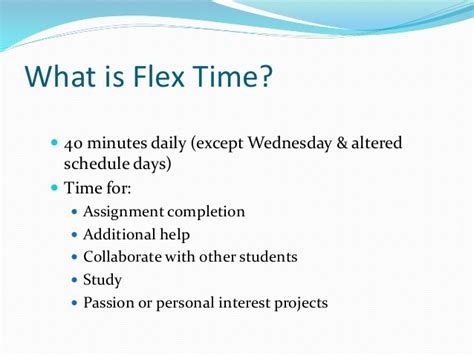Flex Time Explained: Definition & Examples

Are you tired of the traditional 9-to-5 work schedule? Do you wish you had more control over your work hours? If so, flex time might be the solution you’ve been looking for. In this article, we will explore the concept of flex time, its benefits, and provide examples of how it can be implemented in different industries.
What is Flex Time?
Flex time, also known as flexible working hours or flexi-time, is a work arrangement that allows employees to choose their own start and end times within a set range of hours. Unlike the traditional fixed schedule, flex time offers employees the freedom to adjust their work hours according to their personal needs and preferences, as long as they complete their required hours and meet their deadlines.
Benefits of Flex Time
Flex time offers several advantages for both employees and employers:
- Work-life balance: Flex time allows employees to better balance their work and personal life, leading to increased job satisfaction and overall well-being.
- Productivity: Giving employees the autonomy to choose their work hours can result in increased productivity and motivation.
- Reduced commuting stress: With flex time, employees have the flexibility to avoid rush hour traffic and choose less congested times to travel to and from work.
- Attracting and retaining top talent: Offering flex time as a perk can make a company more attractive to potential employees and improve employee retention rates.
- Enhanced teamwork: Flex time can facilitate collaboration among team members who have different working schedules, as they can easily find overlapping hours for meetings and discussions.
Examples of Flex Time
Flex time can be implemented in various ways, depending on the industry and the specific needs of the company. Here are a few examples:
1. Core Hours Model
In the core hours model, employees are required to be present during a set period of time, such as 10 am to 3 pm, to ensure availability for meetings and collaboration. Outside of these core hours, employees have the flexibility to choose their start and end times.
2. Compressed Workweek
The compressed workweek allows employees to work their required hours in fewer days. For example, instead of working five 8-hour days, employees may work four 10-hour days and have an extra day off.
3. Flexitime
Flexitime gives employees the freedom to choose their own start and end times within a broader range of hours, such as 7 am to 9 am for the start time and 3 pm to 6 pm for the end time. As long as employees complete their required hours, they have the flexibility to adjust their schedule.
4. Remote Work
Remote work, also known as telecommuting or working from home, allows employees to work outside the traditional office environment. This arrangement provides the ultimate flexibility in terms of work hours and location.
Implementing Flex Time
If you’re considering implementing flex time in your organization, here are some steps to follow:
- Evaluate the feasibility: Assess whether flex time is suitable for your industry, taking into account factors such as customer demands, teamwork requirements, and job responsibilities.
- Define the guidelines: Establish clear guidelines and policies regarding flex time, including the core hours (if applicable), required hours per week, and any limitations or restrictions.
- Communicate with employees: Inform your employees about the new flex time policy and address any concerns or questions they may have. Emphasize the benefits and how it can contribute to their work-life balance.
- Provide training if needed: If implementing flex time requires new technology or adjustments in workflow, provide the necessary training and support to ensure a smooth transition.
- Monitor and evaluate: Regularly assess the impact of flex time on productivity, employee satisfaction, and overall performance. Make adjustments as needed to optimize the benefits.
FAQs
1. Can all employees participate in flex time?
While flex time can be beneficial for many employees, it may not be suitable for all roles or industries. Some jobs require specific working hours or on-site presence. It’s important to assess the feasibility and impact of flex time on different roles within your organization.
2. How can flex time be managed effectively?
Effective management of flex time involves clear communication, setting expectations, and providing the necessary tools and support for employees to work autonomously. It’s also essential to establish a system for tracking and monitoring work hours and performance.
3. What are the legal considerations of implementing flex time?
Legal considerations may vary depending on the country and jurisdiction. Employers should consult with employment law experts to ensure compliance with labor regulations and to address any legal concerns related to flex time implementation.
4. Can flex time be combined with other work arrangements?
Absolutely! Flex time can be combined with other work arrangements, such as remote work or compressed workweeks, to create a more flexible and customized work schedule that meets the needs of both employees and the organization.
Flex time offers a win-win solution for employees and employers alike. By providing flexibility in work hours, companies can promote work-life balance, increase productivity, and attract top talent. If implemented thoughtfully and effectively, flex time can revolutionize the way we work and create a more satisfied and engaged workforce.
Remember, implementing flex time requires careful planning and consideration of the unique needs of your organization. By taking the necessary steps and ensuring clear communication, you can successfully introduce flex time and reap its many benefits.
